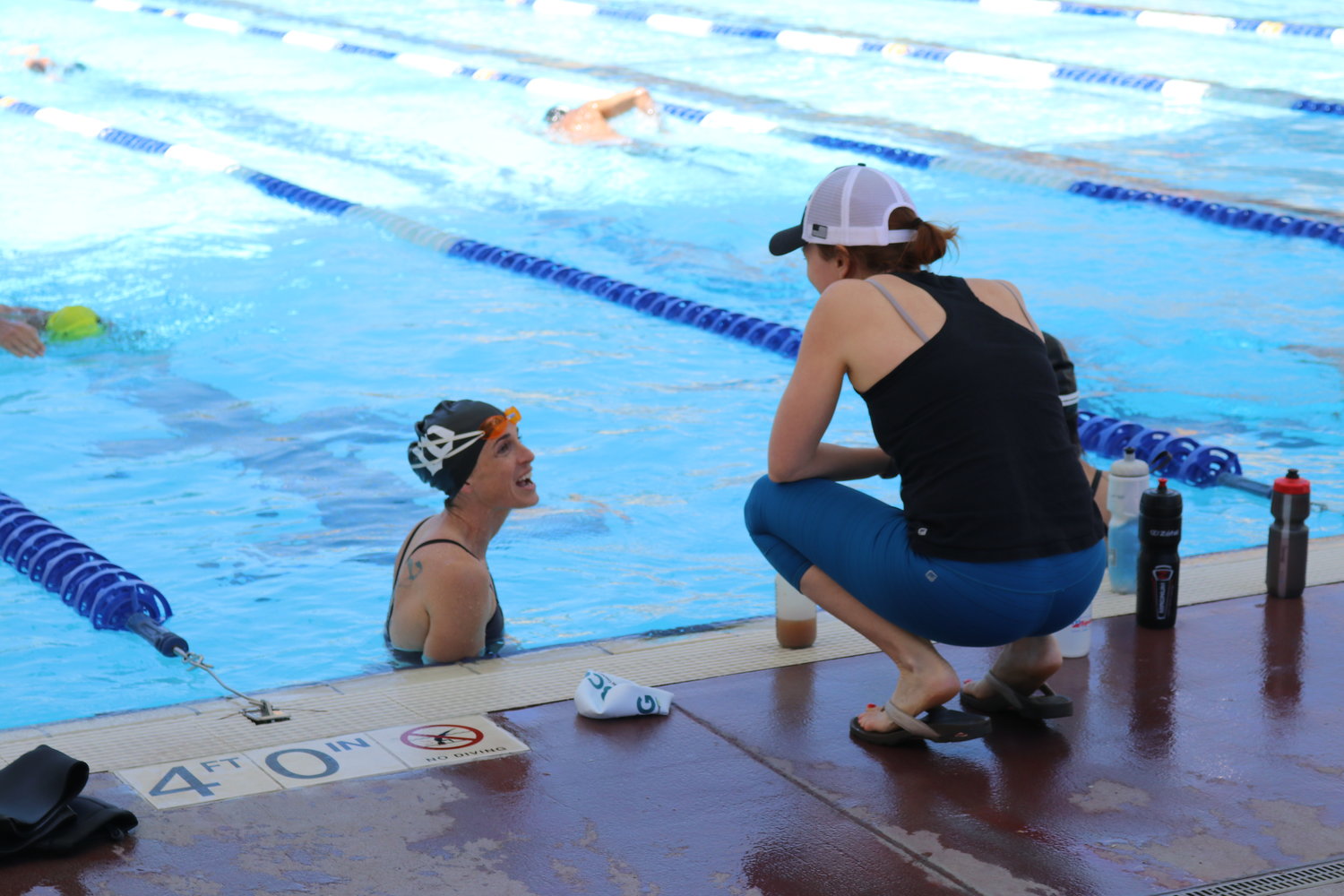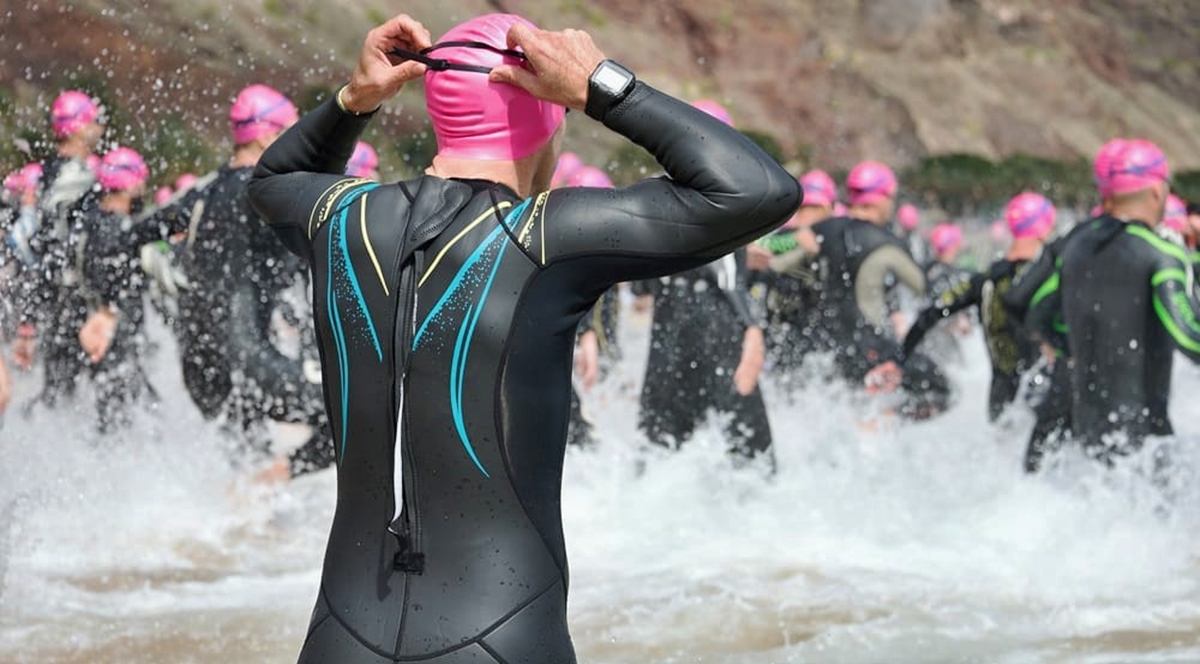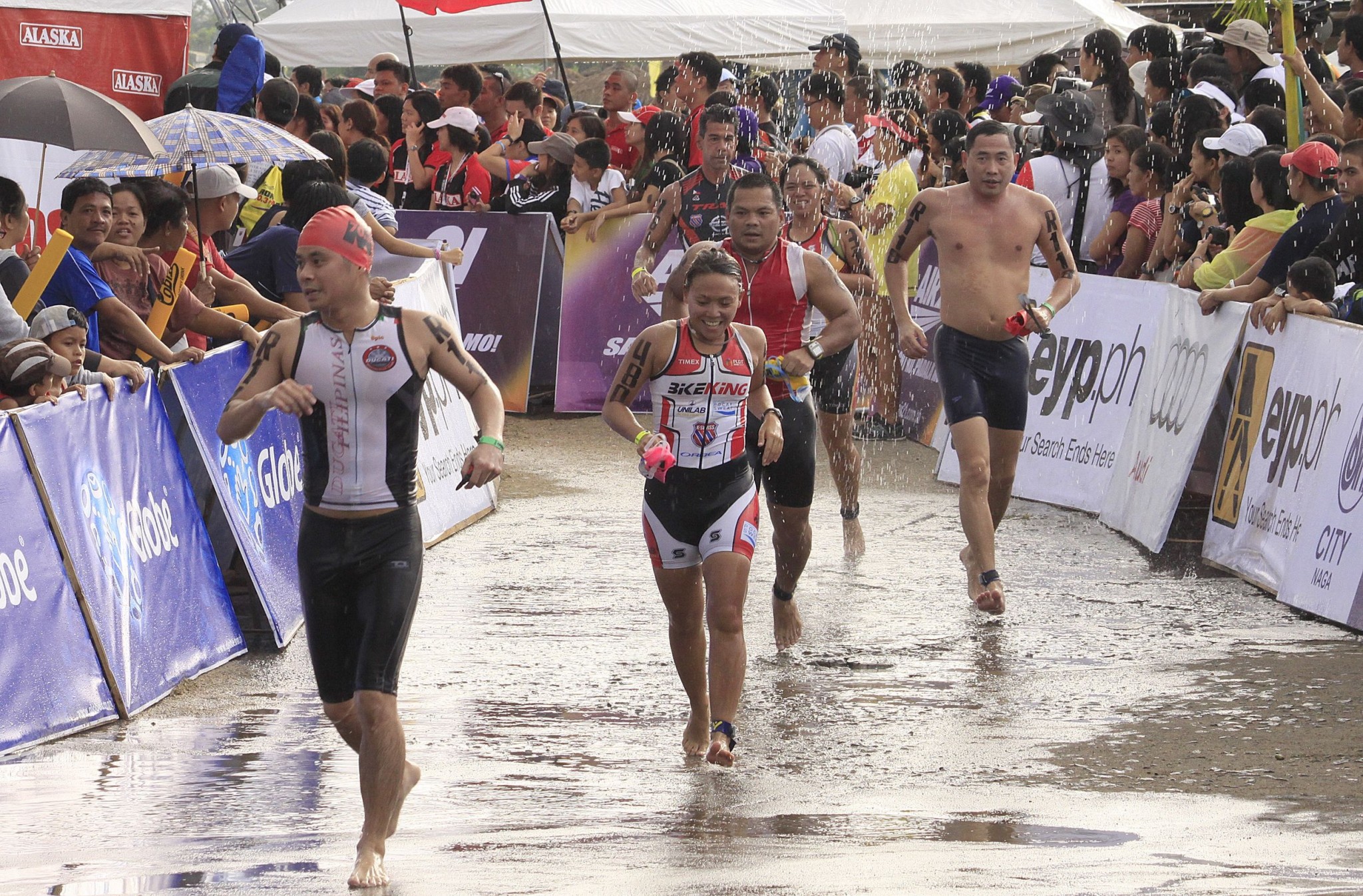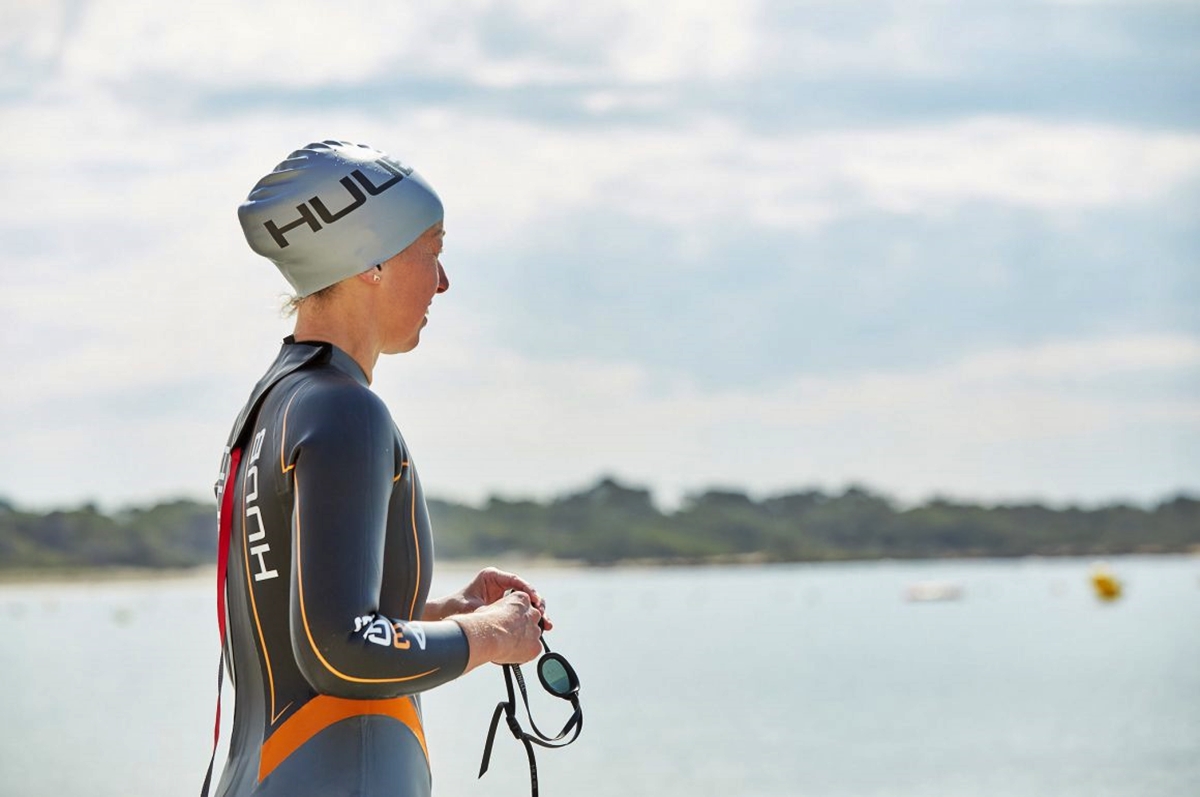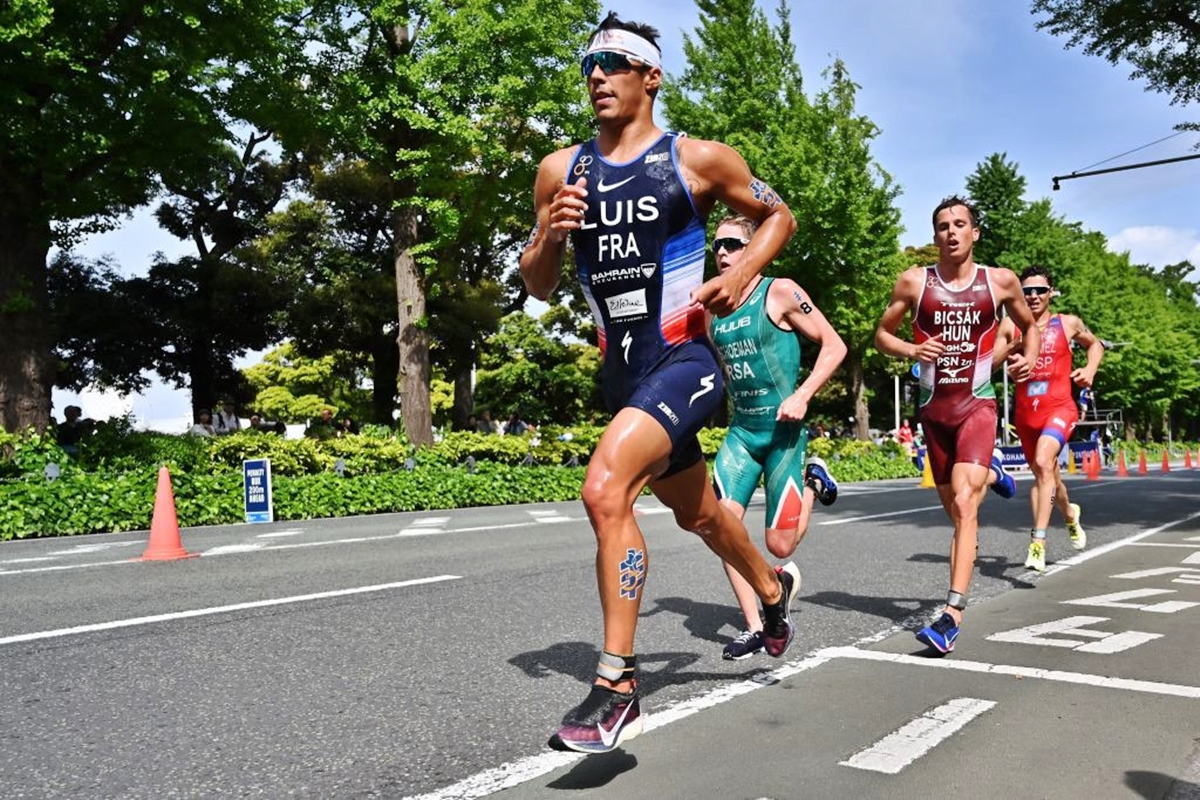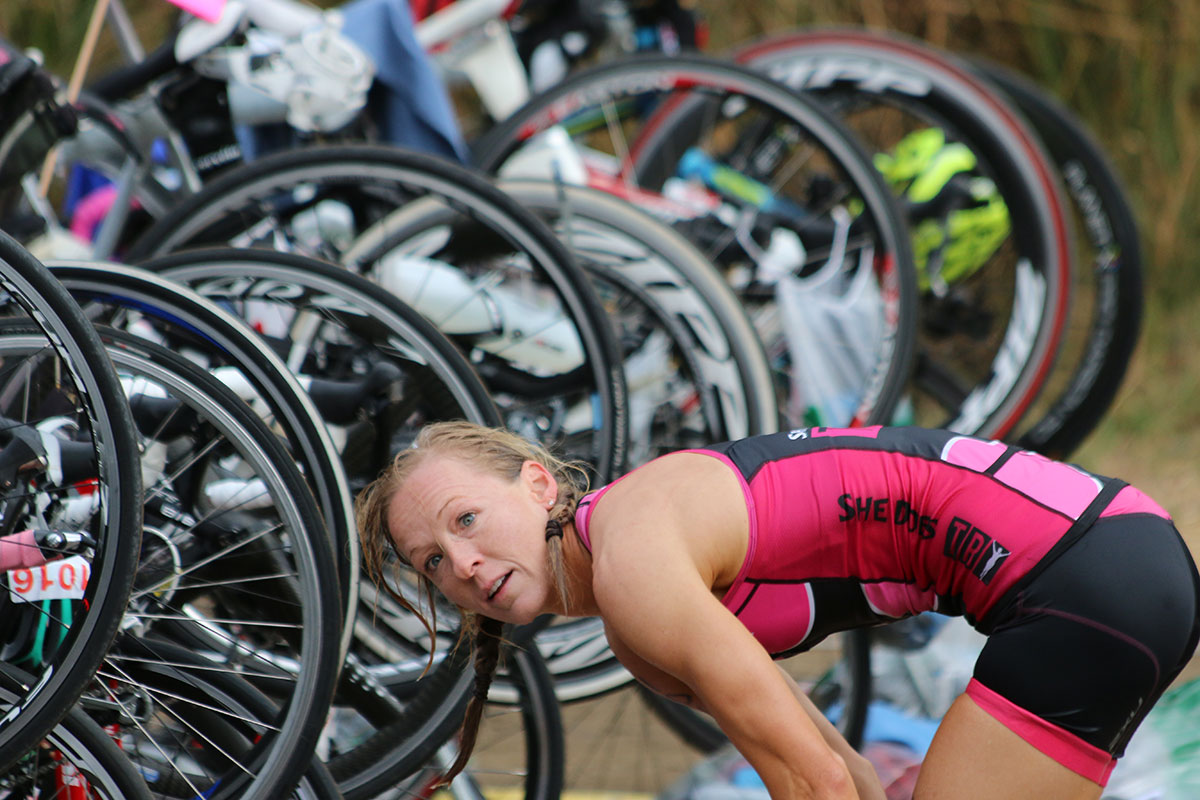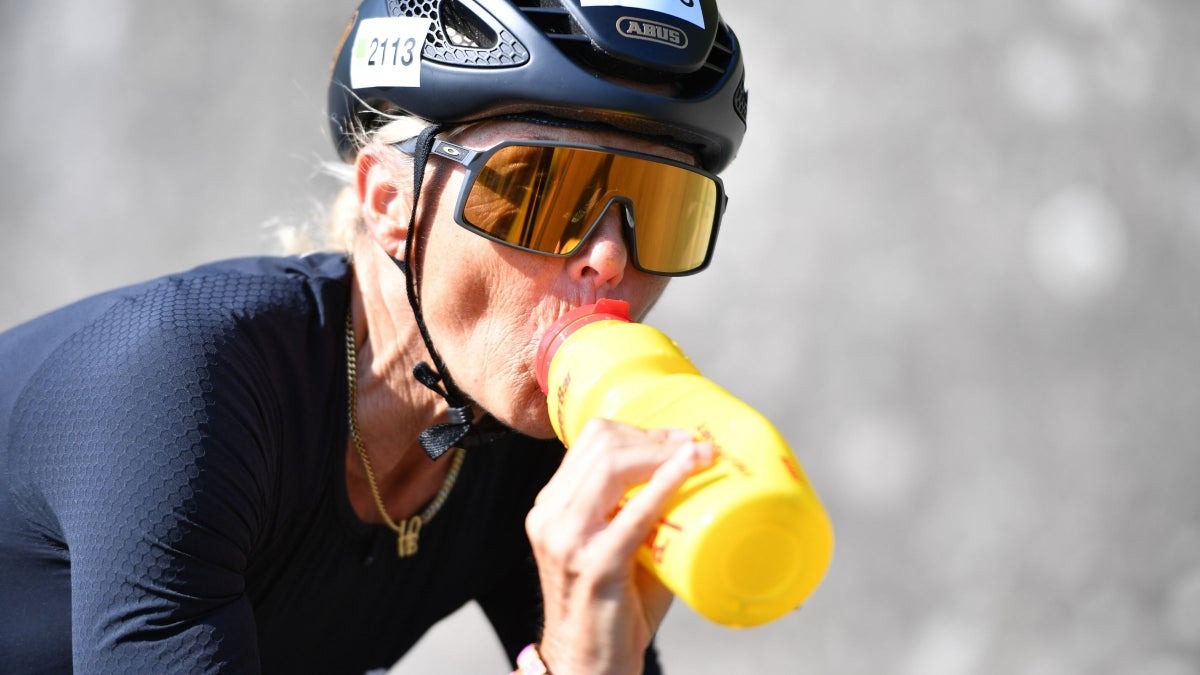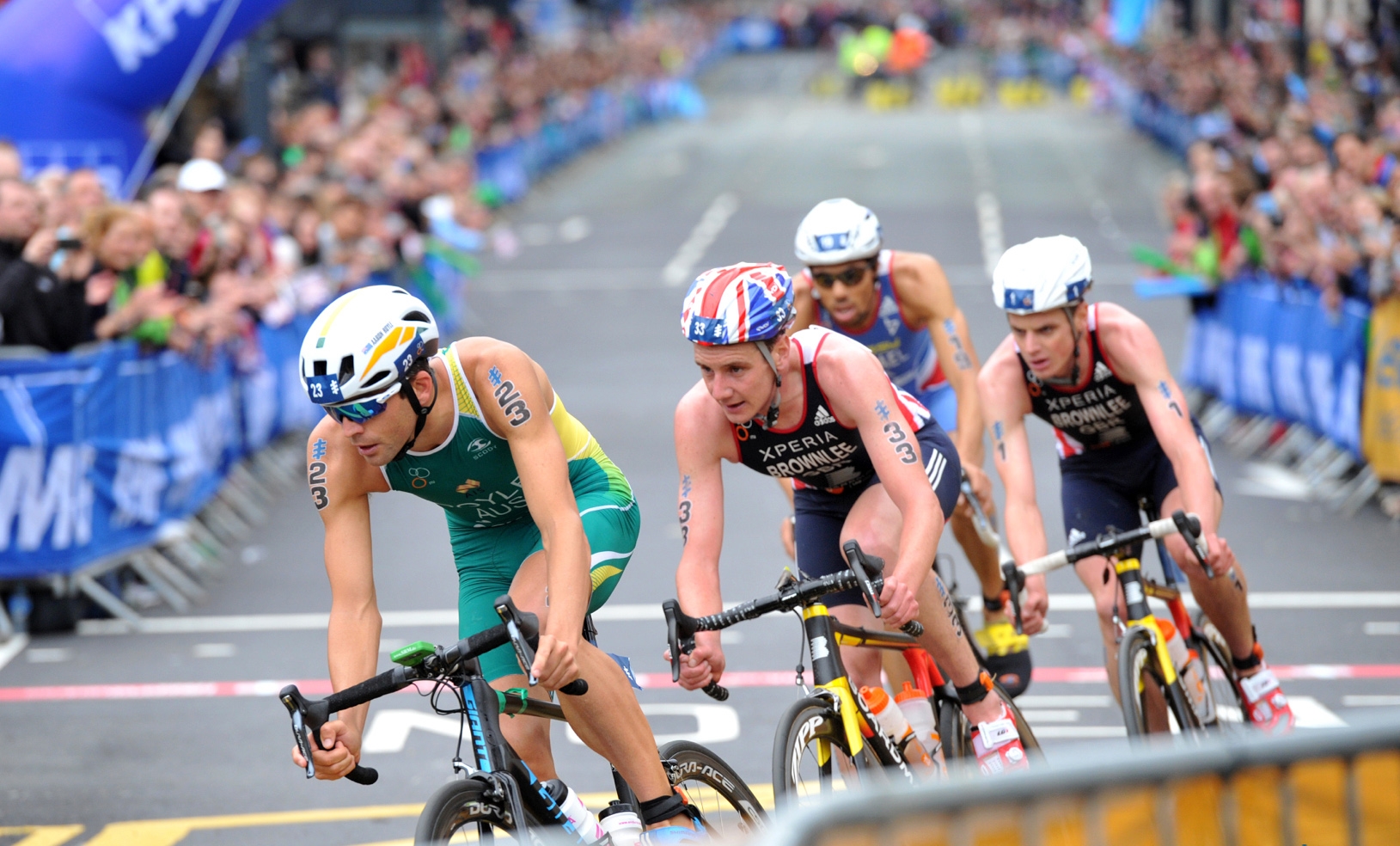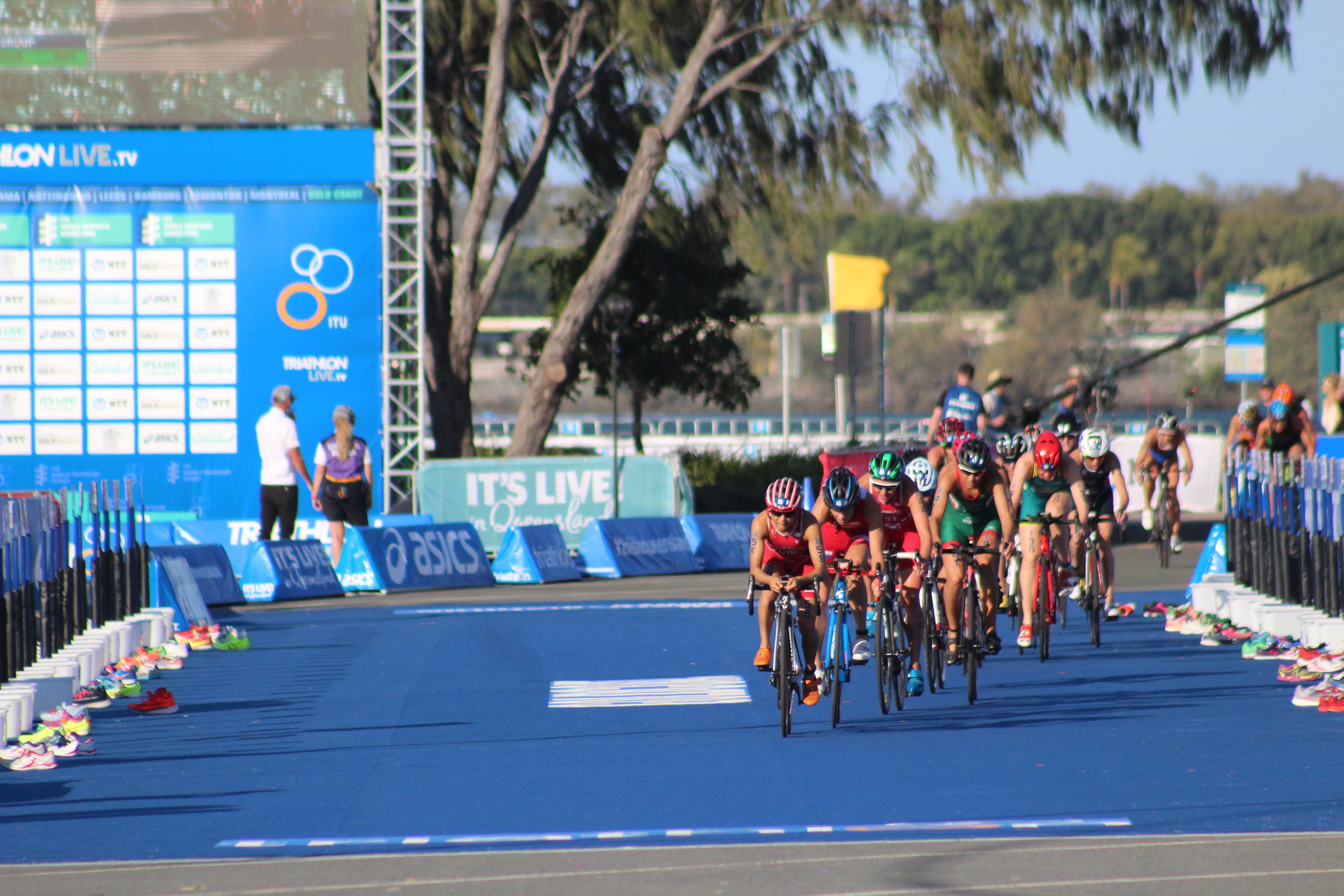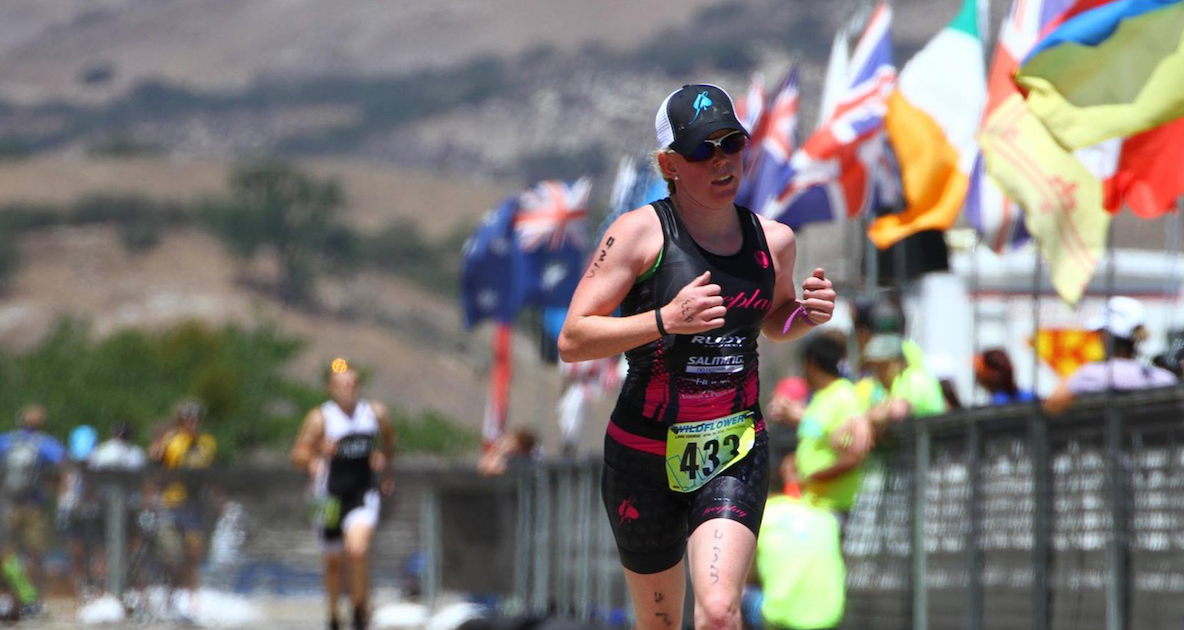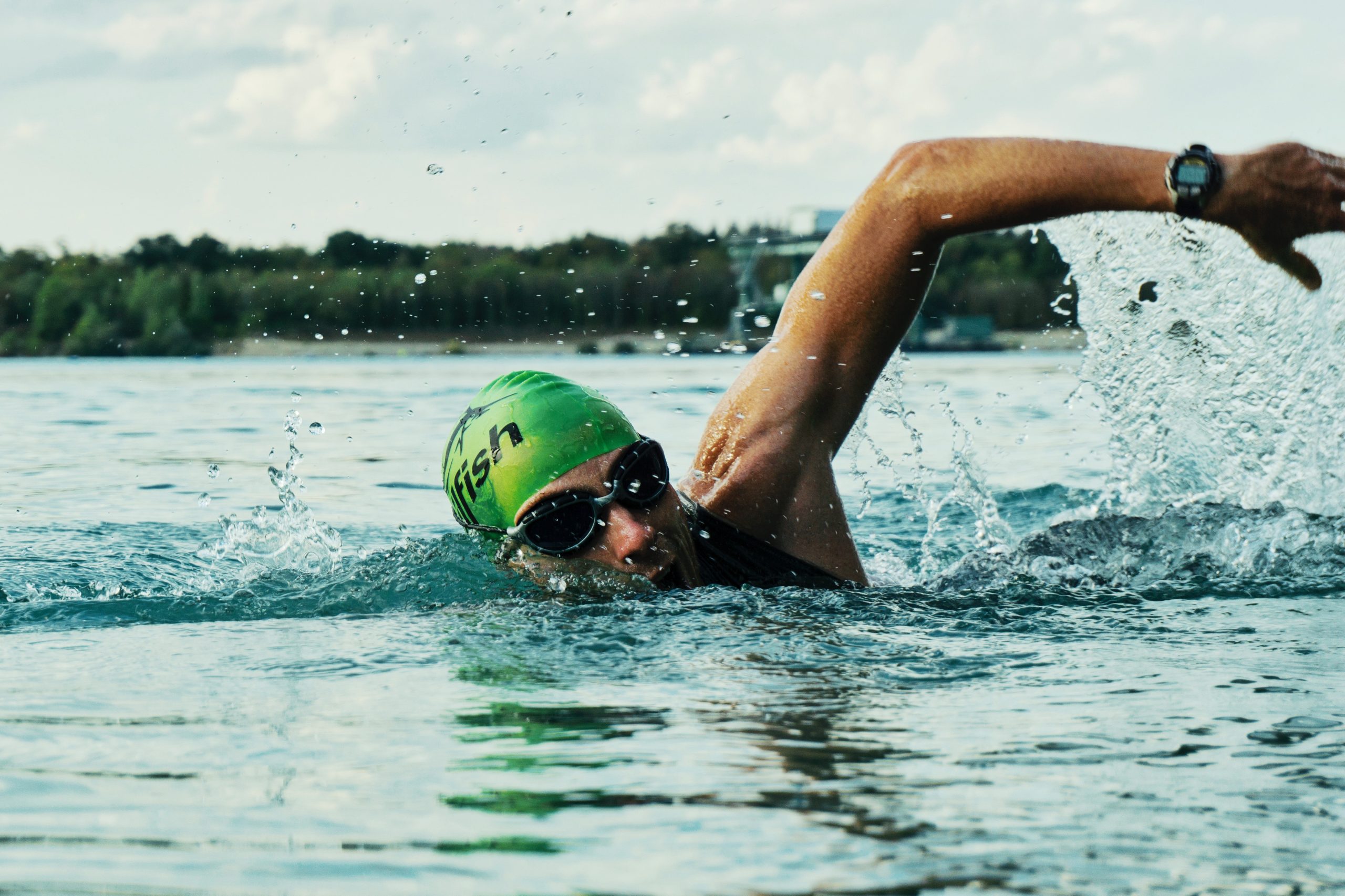

Featured
How To Swim In Triathlon
Modified: January 2, 2024
Learn how to swim in a triathlon with our featured guide, packed with essential tips and techniques to help you conquer the open water.
Introduction
Welcome to the exciting world of triathlon, where athletes push their physical and mental limits to complete three challenging disciplines: swimming, cycling, and running. While all three disciplines are crucial in a triathlon, the swim leg often proves to be the most intimidating for beginners. However, with the right knowledge, preparation, and practice, you can conquer the water and excel in the swim leg of your next triathlon.
Swimming in a triathlon offers numerous benefits. Firstly, it provides a full-body workout, engaging all major muscle groups and improving overall strength and endurance. This low-impact sport also puts minimal stress on the joints, making it an excellent form of exercise for individuals recovering from injuries or looking to cross-train. Additionally, swimming improves cardiovascular health, enhances lung capacity, and boosts flexibility, making it a valuable addition to any fitness routine.
Getting started with swimming in a triathlon requires some essential equipment. A well-fitting swimsuit or triathlon-specific wetsuit, goggles, and a swim cap are the basics. Depending on the type of triathlon, you may also need a wetsuit, which provides buoyancy and insulation in open water swims.
Preparing for the swim leg involves building the necessary skills and technique. Proper body positioning and breathing are vital aspects to focus on. Developing a strong swimming technique ensures efficiency and conserves energy, allowing you to perform well in the other legs of the race. Building endurance and speed in the water requires consistent training and a structured swimming program that progressively increases in intensity.
Incorporating swim workouts into your triathlon training plan is essential to improve your swimming performance. It is important to balance swimming workouts with cycling and running sessions, as well as allow for adequate rest and recovery. Swim workouts can include drills, intervals, and distance swims to develop specific skills and improve overall swim fitness.
Despite the many benefits and training efforts, swimming in a triathlon can come with its own set of challenges. Open water swimming, in particular, can be daunting for those accustomed to pool swims. Overcoming these challenges requires mental preparation, practicing sighting and navigation techniques, and adapting to the unpredictable conditions of open water.
Transitioning from the swim to the bike leg smoothly is also important in a triathlon. Having a well-organized transition area, knowing how to remove a wetsuit quickly, and having your cycling gear ready can save valuable time and energy.
With the right knowledge, preparation, and training, you can overcome the obstacles and excel in swimming during your next triathlon. In the following sections, we will explore these topics in more detail, providing you with the insights and tips needed to become a proficient swimmer in the world of triathlon.
Benefits of Swimming in Triathlon
Swimming in a triathlon offers a myriad of benefits that can transform your overall fitness and enhance your performance in the race. Here are some of the key advantages of including swimming as a part of your triathlon training:
- Full-body workout: Swimming engages all major muscle groups, making it an excellent form of exercise for strengthening your entire body. It targets your arms, legs, core, and back, helping you build lean muscle mass and improve overall strength.
- Low-impact exercise: Unlike running or cycling, swimming is a low-impact sport that puts minimal stress on your joints. This makes it ideal for individuals recovering from injuries or those looking for a cross-training option that won’t exacerbate joint pain.
- Cardiovascular health: Swimming is a highly effective cardiovascular workout that increases your heart rate, improving your cardiovascular fitness and endurance. It helps strengthen your heart, lower blood pressure, and improve circulation, all of which contribute to a healthier cardiovascular system.
- Lung capacity: Swimming requires rhythmic breathing techniques, which help expand your lung capacity and improve respiratory efficiency. This can be particularly beneficial for athletes participating in endurance events like triathlons, where proper breathing plays a critical role in performance.
- Flexibility and mobility: The nature of swimming movements requires a wide range of motion, promoting flexibility and enhancing joint mobility. Regular swimming can help increase your flexibility, making you more agile and less prone to injuries during the race.
- Weight management: As a full-body workout, swimming can burn a significant number of calories. Incorporating swimming into your training routine can help you maintain a healthy weight or assist in weight loss efforts, making it an effective tool for body composition management.
- Stress relief: Swimming has a meditative quality that can reduce stress levels and promote mental relaxation. The rhythmic nature and the sensation of weightlessness in the water can have a calming effect on the mind, making it an excellent activity for stress relief and improving overall well-being.
By incorporating swimming into your triathlon training, you can reap these benefits and enhance your overall fitness and performance. The combination of strength, endurance, cardiovascular fitness, and mental relaxation that swimming provides is a valuable asset in your journey towards becoming a well-rounded triathlete.
Getting Started: Essential Swimming Equipment
Before diving into your triathlon swimming training, it’s important to have the necessary equipment to ensure comfort, safety, and optimal performance in the water. Here are some essential swimming equipment items to consider:
- Swimsuit or Triathlon-specific Wetsuit: A well-fitting swimsuit is essential for comfortable swimming. Opt for a suit made of a durable, quick-drying material that allows for ease of movement. For open water swims, consider investing in a triathlon-specific wetsuit. Wetsuits provide insulation and buoyancy, helping you maintain body temperature and stay afloat.
- Goggles: A good pair of goggles is essential for clear vision and eye protection in the water. Look for goggles that fit securely and have anti-fog lenses. Different styles and sizes are available, so choose one that suits your face shape and provides a comfortable fit.
- Swim Cap: Swim caps help streamline your head and keep hair out of your face, reducing drag and improving hydrodynamics. They also help with visibility and identification in open water swims. Silicone or latex caps are commonly used and provide a snug fit.
- Swim Fins: Swim fins, or flippers, can be beneficial for both beginners and experienced swimmers. They help improve leg strength, propulsion, and body position in the water. When selecting swim fins, choose ones that fit securely and provide ample flexibility.
- Pull Buoy: A pull buoy is a floatation device that is held between the legs to isolate upper body strength and improve arm coordination. It’s a useful tool for focusing on arm technique and developing upper-body strength. Look for a buoy that fits securely and is comfortable to use.
- Kickboard: A kickboard is a foam board that helps isolate lower body movements and develop kick technique. It can be used to enhance leg strength and improve kick coordination. Choose a kickboard that is the appropriate size for your height and offers firm buoyancy.
- Waterproof Fitness Tracker: While not essential, a waterproof fitness tracker can be a useful tool for tracking your swimming distance, pace, and stroke count. It can provide valuable insights into your swim performance and help you track your progress over time.
Investing in quality swimming equipment that fits well and suits your needs can greatly enhance your comfort and performance in the water. It’s important to try out different options and find the equipment that works best for you, taking into account factors such as personal preferences, swimming goals, and the specific demands of your triathlon races.
Preparing for the Swim Leg
Preparing for the swim leg of a triathlon involves building the necessary skills, developing a strong technique, and ensuring you are physically and mentally ready to tackle the water. Here are some key steps to help you prepare for the swim leg of your triathlon:
- Focus on Proper Body Positioning: Body positioning plays a crucial role in swimming efficiency. Aim to maintain a horizontal position in the water, with your hips at the surface and your head in line with your spine. This position reduces drag and allows for smoother and more efficient movement through the water.
- Master Breathing Technique: Proper breathing is vital in swimming. Practice bilateral breathing (breathing to both sides) to ensure balanced muscle development. Develop a rhythmic breathing pattern that works for you, inhaling through your mouth and exhaling through your nose or mouth underwater. Practice breathing drills to improve your technique and comfort in the water.
- Develop a Strong Arm Stroke: Focus on your arm technique to maximize your swimming efficiency. The most common strokes used in triathlon swimming are freestyle (front crawl) and, occasionally, backstroke. Work on elongating your reach, maintaining a high elbow position, and pulling through the water with a firm but relaxed motion. Regular drills can help refine your arm stroke and build muscle memory.
- Improve Kick Technique: While the kick is not as significant in triathlon swimming compared to competitive pool swimming, it still plays a role in maintaining balance and propulsion. Practice kicking drills to improve your kick technique, focusing on generating power from your hips and maintaining a steady and efficient kick rhythm.
- Build Endurance and Speed: Gradually increase your swimming distance and intensity to build endurance and speed in the water. Include interval training, where you swim at a faster pace for a set distance or time, followed by a recovery period. Incorporating longer swims and open water sessions into your training plan will also help you acclimate to the demands and conditions of triathlon swims.
- Practice Open Water Skills: If your triathlon includes an open water swim, it’s essential to familiarize yourself with swimming in open water. Practice sighting (lifting your head to look forward) to navigate and maintain a straight line. Practice swimming in groups to get used to swimming in close proximity to others. Furthermore, consider practicing in similar conditions to your race, such as in a lake or the ocean, to adapt to the specific challenges of open water swimming.
Preparing for the swim leg requires consistent practice and a focus on technique and endurance. Gradually incorporating these aspects into your training plan will ensure that you are well-prepared for the swim leg of your triathlon. Remember to listen to your body, give yourself adequate rest and recovery, and seek guidance from a coach or experienced swimmer if needed.
Developing Proper Swimming Technique
Developing a proper swimming technique is key to swimming efficiently and effectively in a triathlon. Here are some essential tips to help you improve your technique and become a more proficient swimmer:
- Body Positioning: Maintain a horizontal position in the water, with your hips close to the surface and your head aligned with your spine. This reduces drag and allows for efficient movement through the water.
- Arm Technique: Focus on a forward-reaching arm motion with a high elbow catch. Extend your arm forward, entering the water with your fingertips first. Keep your elbow high as you pull back, generating propulsion with the forearm and hand. Maintain a relaxed but firm grip on the water throughout the stroke.
- Hand Entry: Enter the water with a relaxed hand and at a slight angle, fingertips pointing forward. Aim to minimize splashing and create a smooth entry to reduce resistance and maintain forward momentum.
- Breathing: Breathe rhythmically and bilaterally whenever possible. Inhale through your mouth as your head turns to the side, and exhale through your nose or mouth underwater. Practice breathing on both sides to develop balance and symmetry in your stroke.
- Kick Technique: While the kick is not as crucial in triathlon swimming compared to competitive pool swimming, it still contributes to stability and efficiency. Maintain a steady kick rhythm with small, controlled movements originating from your hips. Avoid excessive leg movement that can waste energy and disrupt body positioning.
- Rhythm and Timing: Develop a smooth and rhythmic stroke, maintaining a consistent pace throughout your swim. Coordinate your arm and leg movements to ensure optimal efficiency and reduce wasted energy.
- Drills and Technique Work: Incorporate swimming drills into your training routine to refine specific aspects of your technique. Focus on drills that target areas where you need improvement, such as catch and pull drills, kicking drills, and bilateral breathing drills. Repetition and practice will help reinforce proper technique and build muscle memory.
- Video Analysis: Consider using video analysis to assess and refine your swimming technique. Filming yourself swimming can provide valuable insights, allowing you to identify areas for improvement and make necessary adjustments. Seek guidance from a coach or experienced swimmer to help interpret the analysis and provide recommendations.
Improving your swimming technique takes time, patience, and consistent practice. Incorporate drills, focus on specific aspects of your stroke, and seek feedback from coaches or experienced swimmers to help refine your technique. By developing proper swimming technique, you will swim more efficiently, conserve energy, and perform better in the swim leg of your triathlon.
Building Endurance and Speed in the Water
Building endurance and speed in the water is crucial for a successful swim leg in a triathlon. Here are some strategies and tips to help you improve your swimming performance and increase your stamina:
- Gradual Progression: Start by building a solid foundation of endurance and gradually increase your swimming distance and intensity over time. Begin with shorter swims and gradually progress to longer distances as your fitness level improves.
- Interval Training: Incorporate interval training into your swim workouts to increase your speed and stamina. Alternate between high-intensity efforts and active recovery periods. For example, swim a set distance or time at a fast pace, followed by a slower, easier swim to recover and catch your breath. This helps improve cardiovascular fitness and trains your body to sustain faster speeds.
- Tempo Training: Tempo training involves maintaining a consistent pace over an extended period of time. This trains your body to swim at a steady pace and teaches you to manage your energy efficiently. Use a tempo trainer or a clock to maintain a consistent stroke rate and challenge yourself to hold a specific pace.
- Long Distance Swims: Incorporate longer swims into your training routine to build endurance. Aim to gradually increase your distance, eventually exceeding the length of your race. This helps simulate race conditions and trains your body to swim for an extended period of time without fatigue.
- Open Water Practice: If your triathlon involves an open water swim, it’s essential to practice in similar conditions. Take advantage of opportunities to swim in lakes, oceans, or other open water environments. This helps you adapt to factors such as currents, waves, and sighting, and builds confidence in open water swimming.
- Consistency and Frequency: Regularity and consistency in your swimming training are key. Aim to swim at least two to three times per week to build and maintain endurance and speed. Consistency helps your body adapt and recover between sessions, allowing you to progress more effectively.
- Strength Training: Incorporate dryland exercises into your training program to improve strength and power, which translates to improved swimming performance. Focus on exercises that target the core, upper body, and lower body, such as planks, push-ups, pull-ups, and squats. Strengthening these muscle groups helps enhance swimming technique and endurance.
- Recovery and Rest: Give your body ample time to recover and rest between swim workouts. This allows your muscles to repair and rebuild, which is crucial for improved performance. Incorporate active recovery sessions, such as light swimming or stretching, to aid in recovery and reduce muscle soreness.
Building endurance and speed in the water takes time and consistent effort. Implementing a structured training plan, incorporating interval and tempo workouts, and gradually increasing training volume will help you reach your swimming goals. Stay committed, be patient, and celebrate the progress you make along the way.
Incorporating Swim Workouts into Your Triathlon Training
Succeeding in the swim leg of a triathlon requires proper training and preparation. Incorporating swim workouts into your overall triathlon training plan is essential to improve your swimming performance. Here are some tips to help you seamlessly integrate swim workouts into your triathlon training:
- Create a Structured Training Plan: Develop a well-rounded training plan that includes specific swim workouts. Consider consulting with a coach or experienced swimmer to design a plan that aligns with your triathlon goals and caters to your current abilities.
- Balance Swim, Bike, and Run Sessions: Ensure a balanced training program that includes swim, bike, and run workouts. Allocate sufficient time and effort to each discipline. Triathlon is a multidisciplinary sport, and neglecting any one discipline can hinder overall performance.
- Vary Your Swim Workouts: Include a variety of swim workouts in your training plan to target different aspects of your swimming fitness. Incorporate interval training, endurance sets, technique drills, and open water simulations. This will help you develop a well-rounded swimming ability that translates to success during the race.
- Focus on Technique: Dedicate specific swim sessions to improving your technique. Incorporate drills that target areas for improvement, such as catch and pull drills, kick drills, and bilateral breathing drills. Focusing on technique will enhance your efficiency in the water and conserve energy for the bike and run legs.
- Progressively Increase Intensity and Distance: Gradually increase the intensity and distance of your swim workouts as your fitness improves. Progression in your training is key to building endurance and speed. Monitor your progress and adjust your swim workouts accordingly to continue challenging yourself.
- Incorporate Open Water Sessions: If your race includes an open water swim, devote some swim sessions to practicing in a similar environment. Practice sighting, swimming in a straight line, and navigating around obstacles. Simulating race conditions in the open water will help you feel more confident and prepared on race day.
- Listen to Your Body: Pay attention to your body and give yourself time to recover. Triathlon training can be demanding, and pushing yourself too hard without adequate rest can lead to injury or burnout. Schedule regular rest days and recovery periods to allow your body to heal and adapt.
- Seek Guidance if Needed: If you are new to swimming or struggling with your technique, consider working with a swim coach or joining a Masters swimming group. A coach or experienced swimmer can provide valuable guidance, correct your form, and offer personalized advice to improve your swimming performance.
Incorporating swim workouts into your triathlon training plan is essential for improving your swim leg performance. By following a structured plan, focusing on technique, and gradually increasing intensity and distance, you will develop the necessary swim fitness and skills to excel in the water during your triathlon races.
Overcoming Common Swimming Challenges in a Triathlon
Swimming in a triathlon can present unique challenges that are not encountered in pool swimming. Overcoming these challenges requires preparation, mental fortitude, and focused training. Here are some common swimming challenges in a triathlon and strategies to overcome them:
- Anxiety and Nerves: Many athletes experience anxiety and nerves before the swim leg of a triathlon, especially in open water. To overcome this, practice relaxation techniques such as deep breathing and visualization. Familiarize yourself with the race course and conditions to minimize surprises on race day. Participating in open water swim sessions or mock races can also help build confidence and reduce anxiety.
- Crowded Conditions: Triathlon swims can often be crowded, particularly during mass starts. Prepare for this by practicing swimming in close proximity to others. Join group swim sessions to simulate race conditions and become comfortable swimming in a crowd. Focus on swimming straight and sighting regularly to avoid collisions and minimize added distance.
- Sighting: Sighting, or lifting your head to look forward, is essential for swimming in open water and staying on course. Practice sighting techniques during your training sessions, finding a balance between maintaining a smooth stroke and keeping on track. Utilize landmarks or buoys and develop a rhythmic pattern of sighting to avoid veering off course.
- Navigation: In unfamiliar open water, navigation can be a challenge. Study the race course beforehand, noting any distinguishable landmarks or turns. During training, practice swimming in open water and develop your ability to navigate by using both sighting and peripheral vision. Mental preparation and familiarity with the course will boost your confidence on race day.
- Waves and Choppiness: Uneven and unpredictable water conditions can pose difficulties in open water swims. Practice swimming in different types of water to become comfortable with various conditions. Focus on maintaining a steady rhythm and adapting your stroke to accommodate the choppy water. Building upper body strength and core stability through dryland exercises can also help you handle rough water more effectively.
- Exiting the Water: Exiting the water can be challenging due to fatigue and changes in body orientation. Prepare for this by completing specific sessions that include practice exits. Practice running out of the water smoothly, removing your swim cap and goggles while transitioning to the next leg of the race. Building strength and mobility in your legs through dryland exercises can also assist in a swift transition.
By acknowledging and addressing these common swimming challenges, you can better prepare yourself to overcome them on race day. Regular training, familiarization with the race course, and mental preparation techniques will contribute to your success in conquering these obstacles and achieving your best performance in the swim leg of a triathlon.
Transitioning from Swim to Bike in a Triathlon
The transition from swim to bike is a critical phase in a triathlon, as it sets the tone for the rest of the race. Mastering the transition can save valuable time and ensure a smooth start to the bike leg. Here are some tips to help you transition effectively:
- Know the Flow: Familiarize yourself with the layout and flow of the transition area before the race. Understand where the swim exit is located and the route to your bike. Practice visualizing the transition process to reduce confusion and ensure a seamless transition on race day.
- Layout Your Gear in Advance: Lay out your bike gear in a strategic and organized manner before the race. Place your helmet, sunglasses, cycling shoes, and any other essential gear in a designated spot for easy access. Position them in a way that allows for quick and efficient dressing without wasting time searching for items.
- Practice Transition Drills: Include transition drills in your training sessions to simulate race-day scenarios. Practice running from the swim exit to the transition area, removing your wetsuit efficiently, and swiftly putting on your cycling gear. Repetition helps improve muscle memory and allows you to perform the transition smoothly under race conditions.
- Remove Your Wetsuit: As you exit the water, start peeling off your wetsuit. Unzip it while running towards the transition area to save time. Once in the transition zone, carefully remove the wetsuit, rolling it down to your waist or ankles. Practice this motion to become quicker and more efficient in the process.
- Don’t Rush: While it is important to be efficient, avoid rushing and making mistakes. Take a moment to catch your breath, compose yourself, and ensure you have all your necessary gear. Double-check that your helmet is securely fastened, your cycling shoes are tightened, and everything else is in order before heading out on the bike.
- Mount Your Bike Safely: Locate the designated mount line and mount your bike safely. Be aware of other athletes and follow race rules, which may require you to walk your bike until you reach a certain point. Practice mounting your bike smoothly and finding your rhythm quickly to minimize any time lost in transition.
- Practice Transitions in Training: Regularly incorporate brick workouts into your training plan. These workouts involve a swim followed immediately by a bike or run session. By practicing back-to-back transitions, you will become more familiar with the sensations and challenges of transitioning from swim to bike.
- Plan Your Nutrition: Use the transition period as an opportunity to consume necessary nutrition. Have easily accessible and portable energy gels or snacks available to fuel your body as you transition from swimming to cycling. Keep in mind that hydration is also essential during the bike leg, so consider having a water bottle ready to grab and go.
Transitioning from the swim to bike leg efficiently requires organization, practice, and a calm mindset. By mastering the transition process and making it a seamless part of your race strategy, you will gain valuable time and set yourself up for a strong performance throughout the rest of the triathlon.
Tips for Open Water Swimming in a Triathlon
Open water swimming is a unique challenge in a triathlon, requiring specific skills and strategies to navigate through the water effectively. Here are some tips to help you excel in open water swimming during your triathlon:
- Practice in Open Water: Whenever possible, practice swimming in open water to acclimate yourself to the conditions and challenges it presents. Find a local lake, ocean, or other open water areas where you can swim. Familiarizing yourself with the nuances of open water, such as waves, currents, and sighting techniques, will enhance your confidence and performance on race day.
- Improve Sighting: Sighting is crucial in open water swimming to navigate and stay on course. Practice lifting your head to look for landmarks or buoys and find a sighting rhythm that works for you. Incorporate sighting drills into your training, such as swimming with your eyes closed and intermittently lifting your head to practice quick, efficient sighting.
- Master Drafting: Drafting, or swimming closely behind another swimmer, can benefit you by conserving energy and minimizing resistance. Practice drafting in training sessions with other swimmers and learn to position yourself strategically behind another swimmer’s hip or feet to take advantage of their slipstream. Be respectful of other swimmers and communicate well to avoid collisions or disruptions.
- Control Anxiety: Open water swimming can often stir up anxiety and nerves. Practice relaxation techniques, such as deep breathing and visualization, to manage anxiety before and during the swim. Focus on your own race, stay calm, and remember that everyone is navigating the same challenges as you.
- Start Strong: Begin the swim leg with confidence and a strong start. Position yourself in the water according to your swimming ability and race strategy. If you are a faster swimmer, start near the front to avoid congestion. If you prefer a more measured pace, position yourself accordingly. Practice your race starts during training to get comfortable and find your rhythm quickly.
- Be Aware of Others: In a crowded open water swim, it’s important to be aware of other swimmers around you. Maintain spatial awareness to avoid collisions and stay on course. If you need to overtake another swimmer, communicate your intent, and execute the pass safely and respectfully.
- Stay Focused: Open water swimming requires mental focus and concentration. Stay present and focused on your own stroke, breathing, and technique. Avoid distractions and external factors that may hinder your performance. Trust your training and stay committed to your race plan.
- Prepare for Different Water Conditions: Open water swim conditions can vary greatly from calm lakes to choppy oceans. Practice swimming in different conditions to adapt and be prepared for any scenario. Pay attention to changes in the water on race day and adjust your technique accordingly to navigate the best you can.
Becoming proficient at open water swimming in a triathlon takes practice, experience, and mental fortitude. By incorporating these tips into your training and race preparation, you will be better equipped to handle the challenges of open water and perform your best in the swim leg of your triathlon.
Conclusion
Swimming is a critical component of triathlon and mastering this discipline is essential for success in the sport. By incorporating the tips and strategies outlined in this article, you can improve your swimming skills, increase endurance, and enhance your overall performance in the water.
From understanding the benefits of swimming in triathlon to selecting the essential equipment, preparing for the swim leg, and building proper technique, each aspect of swimming in a triathlon requires focused attention and practice. Open water swimming in a triathlon comes with its own set of challenges, such as navigating through waves, currents, and crowded conditions. However, with preparation, practice, and dedication, these challenges can be overcome.
Incorporating swim workouts into your triathlon training plan, balancing swim, bike, and run sessions, and progressively increasing intensity and distance will ensure steady improvement in your swimming ability. Building endurance and speed, mastering proper technique, and developing open water skills through consistent training and dedication will ultimately enhance your triathlon performance.
Remember, the transition from the swim to the bike leg is a crucial moment in the race, and efficient transitioning can save valuable time. Prepare your gear, practice transition drills, and strive for a smooth and swift transition on race day.
Lastly, open water swimming presents its own unique set of challenges. Practice in open water, master sighting and drafting techniques, control anxiety, and maintain focus to navigate the open water effectively. By following these tips, you can confidently tackle any open water swim in your triathlon.
In conclusion, swimming in a triathlon is a rewarding and challenging endeavor. With consistent training, proper technique, and mental fortitude, you can develop into a proficient swimmer and excel in the swim leg of your next triathlon. So dive in, embrace the water, and enjoy the journey as you become a stronger and more confident triathlete.
